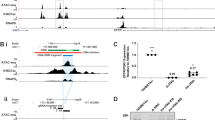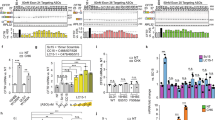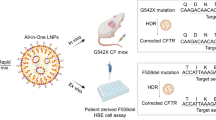Abstract
The development of gene targeting strategies for specific modification of genomic DNA in human somatic cells has provided a potential gene therapy for the treatment of inherited diseases. One approach, small fragment homologous replacement (SFHR), directly targets and modifies specific genomic sequences with small fragments of exogenous DNA (400–800 bp) that are homologous to genomic sequences except for the desired modification. This approach has been effective for the in vitro modification of exon 10 in the cystic fibrosis transmembrane conductance regulator (CFTR) gene in human airway epithelial cells. As another step in the development of SFHR for gene therapy, studies were carried out to target and modify specific genomic sequences in exon 10 of the mouse CFTR (mCFTR) in vivo. Small DNA fragments (783 bp), homologous to mCFTR except for a 3-bp deletion (ΔF508) and a silent mutation which introduces a unique restriction site (KpnI), were instilled into the lungs of normal mice using four different DNA vehicles (AVE, LipofectAMINE, DDAB, SuperFect). Successful modification was determined by PCR amplification of DNA or mRNA-derived cDNA followed by KpnI digestion. The results of these studies showed that SFHR can be used as a gene therapy to introduce specific modifications into the cells of clinically affected organs and that the cells will express the new sequence.
This is a preview of subscription content, access via your institution
Access options
Subscribe to this journal
Receive 12 print issues and online access
$259.00 per year
only $21.58 per issue
Buy this article
- Purchase on Springer Link
- Instant access to full article PDF
Prices may be subject to local taxes which are calculated during checkout





Similar content being viewed by others
References
Flotte TR . Gene therapy for cystic fibrosis Curr Opin Molec Ther 1999 1: 510–516
Gruenert DC . Opportunities and challenges in targeting genes for therapy Gene Therapy 1999 6: 1347–1348
Yanez RJ, Porter ACG . Therapeutic gene targeting Gene Therapy 1998 5: 149–159
Yoon K, Cole-Strauss A, Kmiec EB . Targeted gene correction of episomal DNA in mammalian cells mediated by a chimeric RNA/DNA oligonucleotide Proc Natl Acad Sci USA 1996 93: 2071–2076
Cole-Strauss A et al. Targeted gene repair directed by the chimeric RNA/DNA oligonucleotide in a mammalian cell-free extract Nucleic Acids Res 1999 27: 1323–1330
Alexeev V, Yoon K . Stable and inheritable changes in genotype and phenotype of albino melanocytes induced by an RNA-DNA oligonucleotide Nat Biotechnol 1998 16: 1343–1346
Kmiec EB . Targeted gene repair (editorial) Gene Therapy 1999 6: 1–3
Kren BT, Bandyopadhyay P, Steer C . In vivo site-directed mutagenesis of the factor IX gene by chimeric RNA/DNA oligonucleotides Nature Med 1998 4: 285–290
Culver KW et al. Correction of chromosomal point mutations in human cells with bifunctional oligonucleotides Nat Biotechnol 1999 17: 989–993
Chan PP, Glazer PM . Triplex DNA: fundamentals, advances, and potential applications for gene therapy J Mol Med 1997 75: 267–282
Gruenert DC . Gene correction with small DNA fragments Curr Res Mol Ther 1998 1: 607–613
Goncz KK, Kunzelmann K, Xu Z, Gruenert DC . Targeted replacement of normal and mutant CFTR sequences in human airway epithelial cells using DNA fragments Hum Mol Genet 1998 7: 1913–1919
Kunzelmann K et al. Gene targeting of CFTR DNA in CF epithelial cells Gene Therapy 1996 3: 859–867
Colosimo A et al. Gene targeting of episomal DNA in CF and non-CF epithelial cells Pediat Pulmonol 1998 (Suppl. 17) (Abstr.): 234
Colosimo A et al. Targeted correction of a defective selectable marker gene in human epithelial cells by small DNA fragments Mol Ther 2001 3: 178–185
Colosimo A et al. Transfer and expression of foreign genes in mammalian cells Biotechniques 2000 29: 314–318, 320–322, 324
Schreier H, Moran P, Caras IW . Specific targeting of liposomes to cells using a GPI-anchored ligand; influence of liposome composition on intracellular trafficking J Biol Chem 1994 269: 9090–9098
Gruenert DC . Cystic fibrosis therapy – where we are and how we got there (editorial; comment) West J Med 1996 164: 361–362
Bennett MJ et al. Cationic lipid-mediated gene delivery to murine lung: correlation of lipid hydration with in vivo transfection activity J Med Chem 1997 40: 4069–4078
Gorman CM et al. Efficient in vivo delivery of DNA to pulmonary cells using the novel lipid EDMPC Gene Therapy 1997 4: 983–992
Eastman SJ et al. A concentrated and stable aerosol formulation of cationic lipid:DNA complexes giving high-level gene expression in mouse lung Hum Gene Ther 1997 8: 765–773
Thierry AR et al. Systemic gene therapy: biodistribution and long-term expression of a transgene in mice Proc Natl Acad Sci USA 1995 92: 9742–9746
Hong K, Zheng W, Baker A, Papahadjopoulos D . Stabilization of cationic liposome–plasmid DNA complexes by polyamines and poly(ethyleneglycol)-phospholipid conjugates for efficient in vivo gene delivery FEBS Lett 1997 400: 233–237
Haensler J, Szoka FC . Polyamidoamine cascade polymers and their use for efficient transfection of cells in culture Bioconjugate Chem 1993 4: 85–93
Holmes AR et al. Intracellular compartmentalization of DNA fragments in cultured airway epithelial cells mediated by cationic lipids Pharm Res 1999 16: 1020–1025
Turunen MP et al. Efficient adventitial gene delivery to rabbit carotid artery with cationic polymer-plasmid complexes Gene Therapy 1999 6: 6–11
Goncz K, Yurkovskaya S, Gruenert D . Optimization of in vitro gene transfer into normal and cystic fibrosis airway epithelial cells. In: American Society of Gene Therapy, 2nd Annual Meeting. 1999, Washington, DC p 137a
Kukowska-Latallo J et al. Intravascular and endobronchial DNA delivery to murine lung tissue using a novl, non-viral vector Hum Gene Ther 2000 11: 1385–1395
Roberts JC, Bhalgat MK, Zera RT . Preliminary biological evaluation of polyamidoamine (PAMAM) Starburst dendrimers J Biomed Mat Res 1996 30: 53–65
Alton EW et al. Non-invasive liposome-mediated gene delivery can correct the ion transport defect in cystic fibrosis mutant mice Nat Genet 1993 5: 135–142
McLachlan G et al. Evaluation in vitro and in vivo of cationic liposome expression construct complexes for cystic fibrosis gene therapy Gene Therapy 1995 4: 983–992
Rosenfeld MA et al. Adenovirus-mediated transfer of a recombinant alpha 1-antitrypsin gene to the lung epithelium in vivo Science 1991 252: 431–434
Acknowledgements
We thank Weiwen Zheng for her technical assistance. The work was funded by grants AI 44101 and HL 59239 (JW-K and TS), NIH grants DK46002 and DK47766 as well as grants from the Cystic Fibrosis Foundation, Cystic Fibrosis Research, Inc., and Pennsylvania Cystic Fibrosis, Inc. (DCG, KKG, ZX, AC). We would also like to dedicate this manuscript to our colleague Dr Dimitri Papahadjopoulos, whose untimely death is a tragic loss that has left a void within the scientific community.
Author information
Authors and Affiliations
Rights and permissions
About this article
Cite this article
Goncz, K., Colosimo, A., Dallapiccola, B. et al. Expression of ΔF508 CFTR in normal mouse lung after site-specific modification of CFTR sequences by SFHR. Gene Ther 8, 961–965 (2001). https://doi.org/10.1038/sj.gt.3301476
Received:
Accepted:
Published:
Issue Date:
DOI: https://doi.org/10.1038/sj.gt.3301476
Keywords
This article is cited by
-
The Gene Targeting Approach of Small Fragment Homologous Replacement (SFHR) Alters the Expression Patterns of DNA Repair and Cell Cycle Control Genes
Molecular Therapy - Nucleic Acids (2016)
-
Impact of gene editing on the study of cystic fibrosis
Human Genetics (2016)
-
TALENs Facilitate Single-step Seamless SDF Correction of F508del CFTR in Airway Epithelial Submucosal Gland Cell-derived CF-iPSCs
Molecular Therapy - Nucleic Acids (2016)
-
Nanoparticles that deliver triplex-forming peptide nucleic acid molecules correct F508del CFTR in airway epithelium
Nature Communications (2015)
-
Systemic delivery of triplex-forming PNA and donor DNA by nanoparticles mediates site-specific genome editing of human hematopoietic cells in vivo
Gene Therapy (2013)



